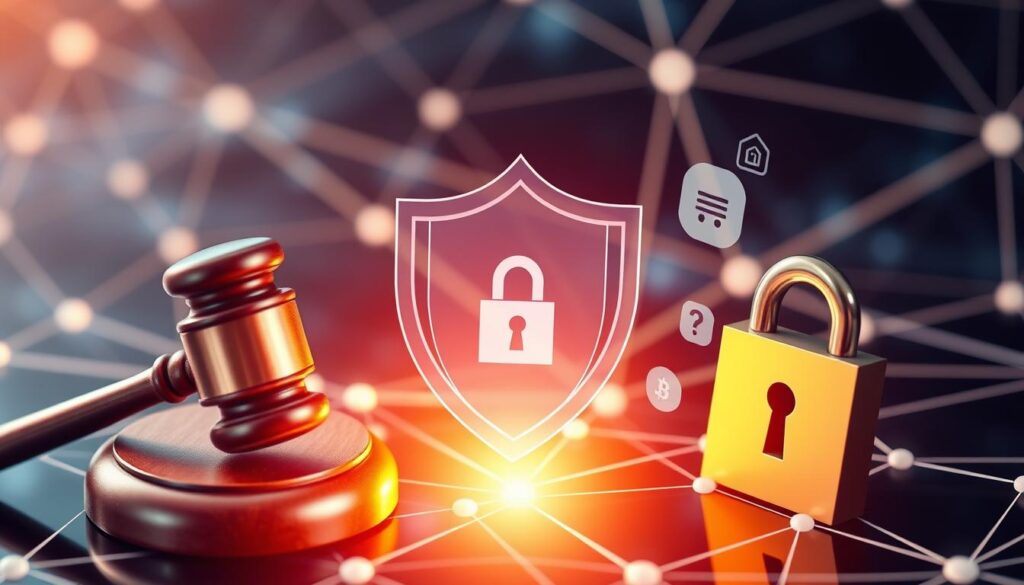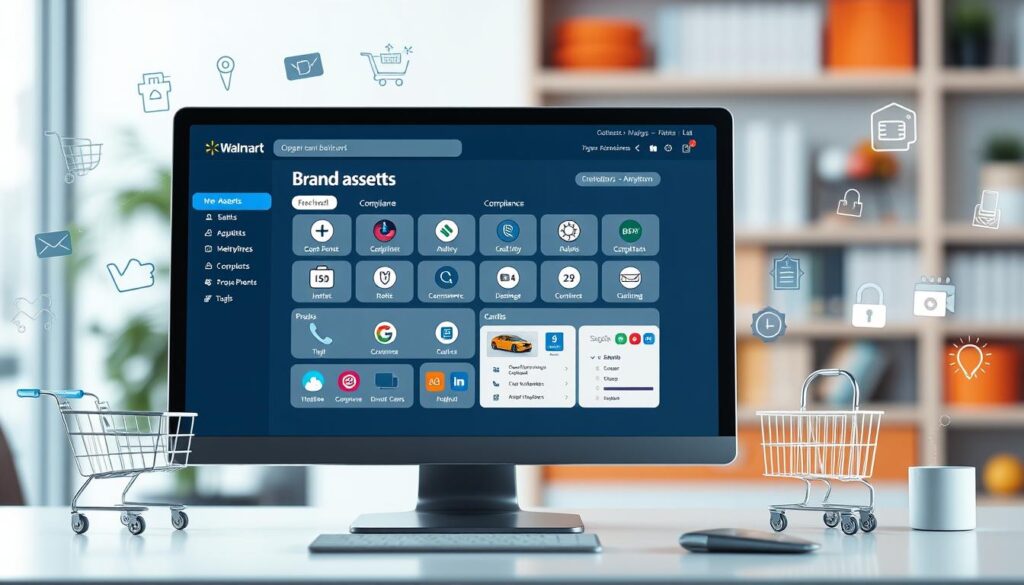Imagine waking up to find your business’s reputation harmed by fake products or bad reviews. In the competitive world of e-commerce, brand protection is more than legal steps. It’s vital armor for your company’s core. Your logo, services, and customer promises are key parts of your brand’s identity. They are at risk without solid online brand security.
But don’t lose hope. There are many ways to protect your brand. Protecting brands online keeps customer trust safe. It also secures the trust you have in your business’s future. With every action for digital brand protection, you make your brand stronger. You turn challenges into bastions of loyalty.
Key Takeaways
- Registering trademarks is essential for exclusive brand rights over logos, names, and slogans.
- Expanding protection through intellectual property safeguards fortifies your brand’s innovations.
- Effective reputation management promptly addresses online mentions and reviews.
- Cybersecurity measures are fundamental in protecting your brand from phishing and other online threats.
- Globalization and cyber threats are evolving, posing new challenges to online brand integrity.
- Building a holistic strategy and fostering collaborations can immensely enhance brand security efforts.
Understanding the Fundamentals of Brand Protection in E-Commerce
In today’s digital marketplace, brand protection is more than just keeping your logo safe. It means protecting trademark, securing intellectual property, ensuring cyber security, and managing your reputation. Your e-commerce brand’s reputation and product authenticity are vital. So, e-commerce brand protection is key in your business strategy.
Defining Brand Protection in the Online Sphere
Online brand protection is your shield against many threats. These can hurt your brand’s integrity and value. It fights fake products and helps manage your online reputation. Good brand protection keeps customers loyal by ensuring they buy the real deal.
The Four Pillars of Digital Brand Protection
E-commerce brand protection stands on four important pillars: trademark protection, intellectual property safeguards, reputation management, and cyber security. Each part is crucial in defending against infringements and threats online. This secures your brand’s online presence.
| Protection Pillar | Description | Key Benefits |
|---|---|---|
| Trademark Protection | Ensures your brand’s unique identity is legally protected against unauthorized use. | Safeguards brand identity, reduces consumer confusion. |
| Intellectual Property Safeguards | Covers patents, copyrights, and design rights to secure your original creations. | Protects against the theft of creativity, securing long-term revenue. |
| Reputation Management | Aims to shape and maintain the public perception of your brand. | Builds and maintains customer trust and loyalty. |
| Cyber Security | Protects your online presence and customer data from cyber threats. | Instills confidence in your customers, ensuring their data is secure. |
Importance of Brand Authenticity in E-Commerce
Keeping your brand authentic is crucial for trust and loyalty, key for e-commerce success. Today’s smart consumers care about product legitimacy. Brand authenticity in e-commerce reassures them about their purchases. This strengthens brand monitoring and boosts your e-commerce brand reputation.
Key Challenges in Brand Protection
While brand protection is critical for any business operating online, it isn’t simple. Companies and platforms must contend with a variety of threats that can undermine their brand integrity and customer trust. Here are three major challenges that every e-commerce seller should understand:
Counterfeit Products:
Fake goods sold as genuine are one of the biggest threats to e-commerce brands. Counterfeits not only divert sales from legitimate businesses but also damage the brand’s reputation if customers receive inferior or unsafe products.Unauthorized Sellers:
These are individuals or companies who list and sell your products without permission. They may offer goods at significantly lower prices or provide inaccurate product descriptions, leading to brand confusion and potential dissatisfaction among customers.Trademark Infringements:
This occurs when someone uses your logo, brand name, or product design without authorization. Trademark violations can dilute your brand’s value and create legal complications, especially in highly competitive markets.
Understanding these challenges is the first step toward creating a robust strategy to safeguard your brand. In the following sections, we’ll explore tools and strategies offered by platforms like Amazon, eBay, Walmart, and Etsy that can help mitigate these risks.
Brand Protection in E-Commerce: A Strategic Imperative
In the world of e-commerce, a e-commerce brand protection strategy is a must. The rise of the digital age has made brand infringement more common. Managing your brand’s reputation is now crucial for your strategy. It’s important to develop a solid brand protection plan. Doing this helps keep your brand safe and maintains customer trust.
Why Your E-commerce Business Needs a Strong Brand Protection Strategy
- It prevents money loss and legal issues from fake goods and stealing ideas.
- Keeping your customers’ trust is key in the competitive online market.
- Using modern cybersecurity steps helps in fighting against illegal acts online.
- Using tools and algorithms to spot fraud helps reduce risks from fake transactions.
The Role of Cybersecurity in Brand Protection
Cybersecurity is crucial in e-commerce. It keeps your brand’s info safe and secures customer buys, making shopping safer. Putting in place tough cybersecurity steps, like checking for intrusions and updating software, will strengthen your e-commerce brand protection strategy.
Teaching your team to protect customer info and using multi-factor authentication and safe payment methods are key. These steps are part of a strong brand reputation management plan.
| Aspect | Benefit |
|---|---|
| Comprehensive cybersecurity measures | Keeps brand info and customer buys safe from online threats |
| Following laws (GDPR, PCI DSS) | Makes sure your business is legal and boosts customer confidence |
| Constant monitoring and quick response | Allows spotting and handling security issues fast |
Making an e-commerce brand protection strategy a key part of your plans protects you from threats. It also helps your brand grow and keeps good customer relations. The aim is to defend and manage risks in the digital world proactively.
Challenges and Threats to Online Brands
The digital market is growing, and so are the risks for e-commerce brand safety. The threat of losing billions in revenue and harming your brand’s reputation is real. Let’s explore solutions for issues like fake products, violations of intellectual property, and damage to your reputation on social media.
Tackling Counterfeit Products in the Digital Marketplace
Every year, counterfeit goods cost the world over $500 billion and create big problems for online counterfeit prevention. Two-thirds of consumers have accidentally bought fake items online, reducing their trust and loyalty to brands. The surge in online shopping has worsened this problem, with fake listings and scam websites tricking customers daily. Fighting counterfeits not only protects your income but also keeps your customers safe from dangerous products.
Addressing Intellectual Property Infringements
E-commerce brand infringement detection is crucial as 40% of brands have faced trademark infringements. Protecting intellectual property in online sales means constant vigilance and quick responses. Now, AI and machine learning are key in spotting and handling these infringements. They help protect your unique ideas and products from misuse.
Combating Reputation Damage in Social Media
Protecting your brand on social media is key since it can greatly influence public perception. Nearly 90% of customers avoid buying from brands with bad online reviews. This shows how important it is to keep a good online reputation. Tactics include monitoring your social media regularly and interacting positively with your audience. This helps build and maintain a positive brand image.
The e-commerce world is full of challenges, but you can protect your brand by taking strategic steps. By setting up strong detection systems for fake goods, defending intellectual property, and managing your online reputation, you can keep your brand strong and trusted in the online marketplace.
Key Legal Measures for Safeguarding Your Brand
To succeed in the e-commerce world, it’s vital to have a legal brand protection framework. This plan fights infringement and boosts your brand’s position. It’s key for staying ahead in the market.

Starting with trademark registration is crucial. A trademark gives you unique rights to your brand’s logo and name. It helps you fight off copies. Making your brand stand out and hard to copy during registration is a big step towards avoiding fakes.
Copyright protection is also essential. It keeps your brand’s original works safe, like website content and marketing materials. While this protection starts automatically, registering formally offers more legal power to act against copies.
- Regular Monitoring: Watching over your brand online and offline helps catch and fix breaches early. It’s vital for keeping your brand’s integrity.
- Decisive Enforcement: If you find someone copying your brand, act fast and firmly. Legal action helps stop and prevent further infringement.
- Digital Safeguarding: Today, a strong digital presence is crucial for brands. Protecting your brand on e-commerce platforms helps manage infringements better.
Using technology improves brand protection. AI and digital tools make guarding your brand more effective and far-reaching. Combining technology with strong legal steps is the best way to protect your brand.
These legal steps, including trademark registration and copyright protection, build customer trust. They give you a market advantage. A protected brand not only survives but also grows, drawing in more customers and earning their loyalty.
Technology Solutions for E-Commerce Brand Safety
Protecting your online business today is more important than ever. Threats like data breaches and fake products are everywhere. That’s why using strong technology to keep your brand safe is a must. Doing so helps keep your customers’ trust.
Monitoring Tools for Brand Protection
Using online brand monitoring tools is key for keeping an eye on your brand’s health. These tools search the web for any misuse of your logo, products, or content. This quick detection lets you act fast against any harm. By using these tech solutions, you safeguard your brand. This upholds your consumers’ trust and your brand’s worth. For deeper insights on brand monitoring, visit this authentic resource.
Implementing Anti-Counterfeit Technologies
Introducing anti-counterfeiting technologies such as holographic labels, and QR codes is crucial. They help separate real products from fake ones. These technologies increase product security and assure customers they’re buying the real deal. A well-protected product shows your dedication to quality and safety.
Securing Your Online Platforms Against Cyber Threats
The rise of e-commerce has made cybersecurity for e-commerce essential. Data protection actions like encryption and secure servers keep your site safe. They protect against cyber threats such as phishing and SQL injections. These threats can harm your customers’ data and hurt your reputation.
Here are some shocking stats that show why strong cybersecurity is vital:
| Cybersecurity Issue | Impact on E-Commerce |
|---|---|
| SQL Injections and XSS Attacks | Data breaches revealing sensitive customer information |
| DDoS and Brute Force Attacks | Significant revenue loss, compromised customer trust |
| E-skimming | Stolen payment information, potential fraudulent transactions |
| Phishing Attacks | Financial damage and erosion of customer confidence |
Dealing with these issues means putting money into top security measures. It also means keeping them up to date. This helps defend your business now and in the future.
Remember, adding brand protection technology and anti-counterfeiting technologies does more than fight off illegal actions. It also boosts customer confidence and trust in your e-commerce setup.
Proactive Brand Reputation Management in E-Commerce
For e-commerce businesses, it’s key to focus on proactive reputation management and keeping your brand credibility strong. Around 81% of shoppers look up brands online before buying. This shows how important it is to protect your brand in the digital world.
Being proactive in managing your reputation helps keep your brand credibility intact. It also reduces the chances of lasting harm to your business. Using tools like Brandverity can help you spot unauthorized ads quickly. This way, you can deal with possible issues fast.
Dealing with negative comments swiftly can lessen their impact. Using online tools to manage your reputation is crucial. Tools for social listening are very important as well. They help you notice and address concerns early on.
Fortune 500 companies follow several methods to boost their brand’s safety and trust. You can use these methods, too:
- Using tools to monitor trademarks helps catch problems early.
- Getting SSL certificates and having strong passwords protect your digital space.
- Checking on affiliate marketing regularly to make sure your brand is represented correctly.
| Strategy | Tool/Method | Benefit |
|---|---|---|
| Domain Monitoring | Automated tools | Catch domain registrations mimicking your brand |
| Negative Feedback Management | Online reputation tools | Quickly handle customer complaints |
| Brand Consistency | Comprehensive brand guidelines | Keeps your brand’s identity the same everywhere |
| Market Analysis | 42Signals and eCommerce analytics | Get insights on market trends and stocks |
| Counterfeit Detection | Advanced monitoring technology | Example: Louis Vuitton identifying fake items |
By using these strategies, you can do more than just safeguard your brand. You can greatly improve your brand credibility and gain the trust of your customers. This is crucial for keeping customers and growing your business in a positive way.
Collaborating for Enhanced Brand Security Online
Protecting your brand today goes beyond old methods. It means working together and using strong tools for today’s challenges. You need to work with big online stores and law enforcement to protect your ideas.
Partnering with E-Commerce Platforms for Protection
Big online shops like Amazon, eBay, and Etsy help fight fake goods and unauthorized selling. The Amazon Brand Registry gives you more control over your product listings. This ensures your products are shown correctly. eBay’s VeRO Program lets you report listings that steal your ideas. Etsy’s Reporting Portal also helps keep your brand safe. These partnerships give you the tools to keep your brand true and respected online.
Joining Forces with Law Enforcement and IP Agencies
Working with law enforcement and IP agencies boosts your rights enforcement. Groups like the USPTO (United States Patent and Trademark Office) are key in this. This partnership is crucial for tackling big issues that online shops can’t manage alone. It makes sure your ideas are protected everywhere.
Staying ahead in the online market means dealing with the challenge of fake sellers. Using big platforms and experts helps you watch and act against these threats. It makes your brand stronger online.
In the end, working together with online platforms and law enforcement helps protect your brand. It also makes the online marketplace safer for everyone.
Leveraging Industry-Specific Brand Protection Programs
The digital world is growing, and so is the need for strong brand protection. Programs like the Walmart Brand Portal show how custom solutions can really help. They fight counterfeits and stop unauthorized sellers online. This keeps your brand safe and makes sure it looks the same everywhere online, which is important for keeping your customers’ trust.

To see how effective these programs are, look at the tools offered by top companies. They are all about keeping online shopping safe. Here are some key solutions:
| Service Provider | Key Offerings | Specialization |
|---|---|---|
| Globaleyez | Brand protection services | Over 15 years of experience in the field |
| MikeLegal | Mike TM Manager, MikeTM Search, MikeTM Watch | IP protection in various industries in India |
| Allure Security | AI-driven brand protection | Streamlining processes, reducing manual effort |
| Domain Crawler | Fraudulent website detection | Comprehensive domain and backlink data analysis |
| SnapDragon | Self-service and managed solutions | Flexible support levels |
| Nabcore | Physical and digital tracking technologies | Customized brand protection across distribution channels |
| LifeRaft | Navigator software | OSINT for proactive online threat detection |
The Walmart Brand Portal is a great example of how useful these platforms can be. It gives you the tools to protect and manage your brand on Walmart’s big online platform. This is very important today, with e-commerce offering both chances and risks. Using these tools can make a big difference in how well you can keep your brand safe.
Choosing the right mix of services depends on what your brand needs and the risks you might face. By using specialized brand protection services, you can protect your brand’s image and keep your customers safe online.
Sustaining Brand Value Through Continuous Monitoring and Enforcement
In the ever-changing e-commerce world, keeping your brand’s value high is essential. Using real-time brand infringement detection and digital brand monitoring helps protect your brand. This ensures it stays strong in a competitive market.
Real-time Detection of Brand Infringements
The rise of online marketplaces has increased brand infringements. Tools such as Brand Registry by Amazon and Gray Falkon’s AI-driven monitoring solutions lead the fight against these issues. They provide real-time alerts. This enables brands to catch unauthorized sellers and fake products quickly. Counterfeit products are expected to cost the global economy over $500 billion a year.
Swift Action Protocols to Counter Infringements
After spotting a threat, the success of your response strategies is key. Using strong brand protection tools like Gray Falkon’s automated features aids in fast action against violations. Legal approaches, like those used by Louis Vuitton, strengthen these efforts. They help react quickly to protect customer trust and avoid losing money.
| Tool | Function | Impact |
|---|---|---|
| Amazon Brand Registry | Trademark protection and counterfeit detection | Reduces counterfeit sales, enhances brand control |
| Gray Falkon AI Monitoring | Real-time detection across multiple platforms | Immediate infringement alerts, quick response capability |
| Project Zero by Amazon | Automated counterfeit removal | Ensures only authentic products are sold, maintaining brand reputation |
| Legal Enforcement (Generic) | Litigation against infringers | Deters brand abuse, preserves intellectual property rights |
By adding these high-tech tools and methods to your e-commerce strategy, you don’t just protect your brand. You also boost its value worldwide. Constant monitoring and quick enforcement are vital to deal with digital brand monitoring challenges. This will help your business succeed in the e-commerce world.
Conclusion
Protecting your brand in e-commerce is more than just a safeguard. It’s key for your business’s survival and success. We’ve explored how vital it is to keep your brand experience consistent and maintain customer trust. A shocking fact is that counterfeit goods represent about 3.3% of world trade. This leads to a huge financial loss of $509 billion annually. It’s a big wake-up call showing the real risks and harsh outcomes.
The high costs, brand damage, and loss of customer trust highlight the urgent need for strong brand protection strategies. With 84% of consumers worried about fake products, it’s your job to protect your assets. It’s also crucial to reassure your customers about the authenticity of their buys. Plus, companies that fight for their intellectual property rights often win in court. This shows how important legal knowledge is in this fight against trademark breaches.
Working together increases our chances to beat counterfeiters by 40%. This shows how much we need partnerships with other companies and law enforcement. Also, teaching our customers has raised awareness by 25%. This reminds us how critical honesty and information are. By using tools like Google Alerts, BrandVerity, and Mention, and being active on social media, we’re not just reacting to threats. We’re building a strong and competitive online business.
FAQ
What is brand protection in the context of e-commerce?
What are the four pillars of digital brand protection?
How important is brand authenticity in e-commerce?
What are the risks of counterfeit products in the digital marketplace?
How can brands address intellectual property infringements online?
What role does social media play in protecting a brand’s reputation?
Why are legal protections such as trademarks and copyrights essential for a brand in e-commerce?
What monitoring tools are available to assist with online brand protection?
How do anti-counterfeit technologies work to protect brands?
What cybersecurity measures should an e-commerce business take to secure its online platforms?
How can e-commerce businesses manage their reputation proactively?
Why is it important for brands to collaborate with e-commerce platforms and law enforcement?
How do real-time detection and swift action protocols benefit brand protection?
Source Links
- Brand Protection: Safeguard Your Brand in the Modern Era | Mailchimp – https://mailchimp.com/resources/brand-protection/
- The Ultimate Guide to Brand Protection: Safeguarding Your Brand – https://blackbird.ai/blog/guide-to-brand-protection/
- 6-Step Brand Protection Strategy Template And Example – BrandBuildr.ai – https://brandbuildr.ai/brand-protection-strategy/
- The Fundamentals of Ecommerce – IV Creative – https://iv-creative.co.uk/the-fundamentals-of-ecommerce/
- New WTR Special Report reveals what the future holds for brand protection on social media – https://www.worldtrademarkreview.com/article/new-wtr-special-report-reveals-what-the-future-holds-brand-protection-social-media
- E-commerce Security: Protecting Your Business and Customers – https://www.cm-alliance.com/cybersecurity-blog/e-commerce-security-protecting-your-business-and-customers
- Brand protection and security: Brand Security in the E commerce Era: Challenges and Solutions – FasterCapital – https://fastercapital.com/content/Brand-protection-and-security–Brand-Security-in-the-E-commerce-Era–Challenges-and-Solutions.html
- Emerging Trends in eCommerce Brand Protection – GreyScout – https://greyscout.com/emerging-trends-in-ecommerce-brand-protection/
- Experts insist on collaboration and education as e-commerce and advanced tech threaten brand protection – https://www.worldtrademarkreview.com/article/experts-insist-collaboration-and-education-e-commerce-and-advanced-tech-threaten-brand-protection
- Safeguarding your brand: A comprehensive guide to brand protection – https://www.delarue.com/articles/safeguarding-your-brand-a-comprehensive-guide-to-brand-protection
- 11 Brand Protection Strategies CISOs Need to Implement – https://cybelangel.com/11-brand-protection-strategies-cisos-need-to-implement/
- 3 essential brand protection strategies for businesses of all sizes – https://www.redpoints.com/blog/brand-protection-strategies-for-businesses-of-all-sizes/
- Ecommerce Security: How to Secure Your Ecommerce Site from Online Threats – https://www.bigcommerce.com/articles/ecommerce/ecommerce-website-security/
- Tech-enabled Brand Protection to tackle infringements – Abion – https://abion.com/expertise/brand-protection/
- The 13 Most Effective Ways to Protect Your Brand Online – https://www.brandverity.com/blog/the-13-most-effective-ways-to-protect-your-brand-online
- The Importance of Online Brand Protection for Modern Businesses – https://www.42signals.com/blog/importance-of-online-brand-protection/
- The Rise of Brand Protection Technologies in eCommerce | Gray Falkon – https://grayfalkon.com/the-rise-of-brand-protection-technologies-in-ecommerce/
- Marketing Needs More Collaboration with Security – https://www.destinationcrm.com/Articles/CRM-Insights/Insight/Marketing-Needs-More-Collaboration-with-Security-166366.aspx
- Brand Enhancement – OpSec Security – https://www.opsecsecurity.com/insights/everything-you-ever-wanted-to-know-about/brand-enhancement/
- The 7 Best Brand Protection Services – https://liferaftlabs.com/blog/7-best-brand-protection-services
- Why Brand Protection is Essential for Your 2024 Budget Plan – https://greyscout.com/why-a-brand-protection-solution-is-a-must-have-in-your-2024-budget-plan/
- eCommerce Brand Protection Tools: What Do They Do? | Gray Falkon – https://grayfalkon.com/ecommerce-brand-protection-tools-what-do-they-do/
- What is Brand Protection and Why is it Important Today! – https://blog.acviss.com/what-is-brand-protection-and-why-it-is-important-today
- The complete guide to online brand protection (solutions and tips) – Valimail – https://www.valimail.com/blog/online-brand-protection/
- Safeguarding Your Brand: The Importance of Brand Protection in the Modern Era – Redinext Blog – https://redinext.com/blog/redinextnews/safeguarding-your-brand-the-importance-of-brand-protection-in-the-modern-era/
- Online Brand Protection: How to Safeguard Your Digital Reputation – https://www.brandverity.com/blog/online-brand-protection-how-to-safeguard-your-digital-reputation
- Intellectual Property for E-commerce: Protecting Your Bright Ideas (and Silly Ones, Too!) – https://www.linkedin.com/pulse/intellectual-property-e-commerce-protecting-your-bright-devin-miller-amjpc


